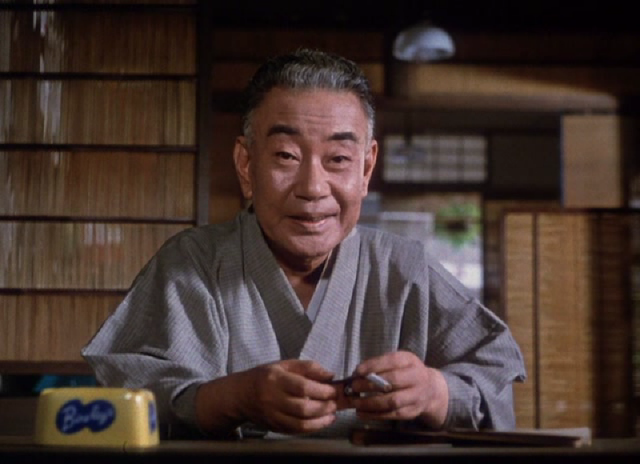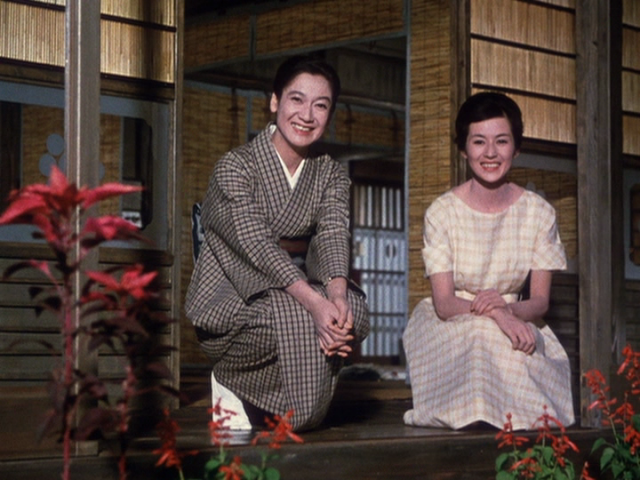
Ganjirō Nakamura is a sheer delight as the unpredictable patriarch of the Kohayagawa family in THE END OF SUMMER
THE END OF SUMMER (KOHAYAGAWA-KE NO AKI) (Yasujirō Ozu, 1961)
Film Forum
209 West Houston St.
Tuesday, July 16, 1:00, 3:15, 5:30, 7:40, 9:50, and Wednesday, July 17, 1:00, 3:15, 5:30
Series runs through July 25
212-727-8110
www.filmforum.org
 Yasujirō Ozu’s next-to-last film, 1961’s The End of Summer, is a poignant examination of growing old in a changing Japan; Ozu would make only one more film, 1962’s An Autumn Afternoon, before passing away on his sixtieth birthday in December 1963. Ganjirō Nakamura is absolutely endearing as Manbei Kohayagawa, the family patriarch who heads a small sake brewery. The aging grandfather has been mysteriously disappearing for periods of time, secretly visiting his old girlfriend, Sasaki (Chieko Naniwa), and her daughter, Yuriko (Reiko Dan), who might or might not be his. In the meantime, Manbei’s brother-in-law, Kitagawa (Daisuke Katō), is trying to set up Manbei’s widowed daughter-in-law, Akiko (Setsuko Hara), with businessman Isomura Eiichirou (Hisaya Morishige), while also attempting to find a proper suitor for Manbei’s youngest daughter, Noriko (Yoko Tsukasa), a typist with strong feelings for a coworker who has moved to Sapporo. Manbei’s other daughter, Fumiko (Michiyo Aratama), is married to Hisao (Keiju Kobayashi), who works at the brewery and is concerned about Manbei’s suddenly unpredictable behavior. When Manbei suffers a heart attack, everyone is forced to look at their own lives, both personal and professional, as the single women consider their suitors and the men contemplate the future of the business, which might involve selling out to a larger company. “The Kohayagawa family is complicated indeed,” Hisao’s colleague tells him when trying to figure out who’s who, an inside joke about the complex relationships developed by Ozu and longtime cowriter Kôgo Noda in the film as well as in the casting.
Yasujirō Ozu’s next-to-last film, 1961’s The End of Summer, is a poignant examination of growing old in a changing Japan; Ozu would make only one more film, 1962’s An Autumn Afternoon, before passing away on his sixtieth birthday in December 1963. Ganjirō Nakamura is absolutely endearing as Manbei Kohayagawa, the family patriarch who heads a small sake brewery. The aging grandfather has been mysteriously disappearing for periods of time, secretly visiting his old girlfriend, Sasaki (Chieko Naniwa), and her daughter, Yuriko (Reiko Dan), who might or might not be his. In the meantime, Manbei’s brother-in-law, Kitagawa (Daisuke Katō), is trying to set up Manbei’s widowed daughter-in-law, Akiko (Setsuko Hara), with businessman Isomura Eiichirou (Hisaya Morishige), while also attempting to find a proper suitor for Manbei’s youngest daughter, Noriko (Yoko Tsukasa), a typist with strong feelings for a coworker who has moved to Sapporo. Manbei’s other daughter, Fumiko (Michiyo Aratama), is married to Hisao (Keiju Kobayashi), who works at the brewery and is concerned about Manbei’s suddenly unpredictable behavior. When Manbei suffers a heart attack, everyone is forced to look at their own lives, both personal and professional, as the single women consider their suitors and the men contemplate the future of the business, which might involve selling out to a larger company. “The Kohayagawa family is complicated indeed,” Hisao’s colleague tells him when trying to figure out who’s who, an inside joke about the complex relationships developed by Ozu and longtime cowriter Kôgo Noda in the film as well as in the casting.

Akiko (Setsuko Hara) and Noriko (Yoko Tsukasa) represent old and new Japan in Ozu’s penultimate film
The End of Summer tells a far more serious story than Late Spring and many other Ozu films that deal with matchmaking and middle-class Japanese life, both pre- and postwar. The perpetually smiling Hara, who played unrelated women named Noriko in three previous Ozu films, once again plays a young widow named Akiko here, as she did in Late Autumn, while Tsukasa, who played Hara’s daughter in Late Autumn, now takes over the name of Noriko as Akiko’s sister. Late Autumn also featured a character named Yuriko Sasaki, played by Mariko Okada, who went on to play a woman named Akiko in Ozu’s final film, An Autumn Afternoon. Got that? Ozu’s fifth film in color, The End of Summer uses several beautiful establishing shots that incorporate flashing light and bold hues — including a neon sign that declares “New Japan” — photographed by Asakazu Nakai (Seven Samurai, Throne of Blood, Ran), as well as numerous carefully designed set pieces that place the old and the new in direct contrast, primarily when Akiko and Noriko are alone, the former in a kimono, the latter in more modern dress. But at the center of it all is Nakamura, who plays Manbei with a childlike glee, as if Ozu is equating birth and death, the beginning and the end. The film is screening July 16 & 17 at Film Forum, which is holding a “Reprise Presentation” of its earlier, extensive Ozu series with encore screenings of eight of the works, continuing with The Flavor of Green Tea over Rice, Early Summer, Tokyo Twilight, Equinox Flower, and Late Autumn.